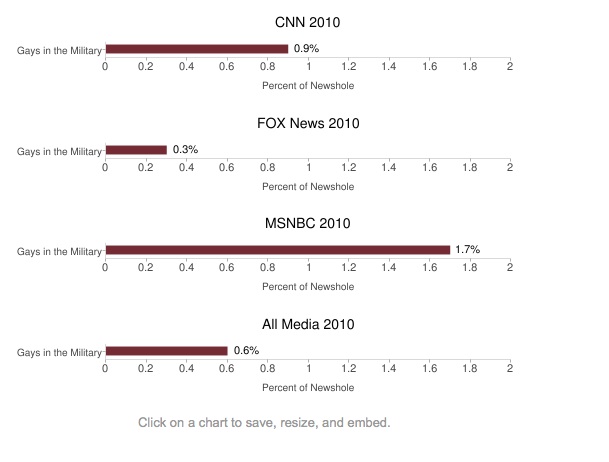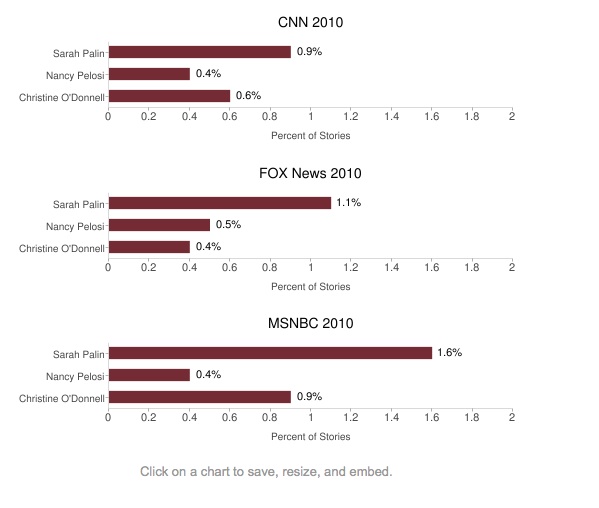Forgive us for not noting this sooner—our attention has been devoted to the Giffords shooting and debates that followed. But a big hat-tip to the Pew Research Center’s Project for Excellence in Journalism for their interactive project “The 2010 Year in the News.” The tool allows you to compare and contrast the media’s coverage of 2010’s biggest stories, newsmakers, and topics, and visualize how much of the “newshole” different outlets and sections of the media devoted to stories and subjects throughout the year. You can even search by quarter. The methodology is complicated, but broadly the source material is summarized here:
The 2010 analysis totals 50,508 stories examined from January 1 through December 19, 2010. This consists of 5,414 newspaper articles, 7,523 online stories, 12,524 stories from network television, 16,338 stories on cable news and 8,709 stories from radio programs.
Pew then created a “News Coverage Index.”
The primary aim of the Index is to look at the main news stories of the week across the industry. With that in mind, for outlets and publications where time does not permit coding the entire news content offered each day (three hours of network morning programming, for instance), we code the lead portion. In other words, we code the first 30 minutes of the cable news programs, the first 30 minutes of the network morning news programs, the front page of newspapers, etc. This may skew the overall universe toward more “serious” stories, but this is also the most likely time period to include coverage of the “main” news events of the day, those that would make up the top stories each week or each month.
For a look at the full methodology check out Pew’s explanation here.
Working the interactive is simple. You first select up to four media sectors, which range from the broad (“All Media,” “Talk Radio,” “Large Papers,” “Online,” etc.) to the specific (ABC, CBS, NPR, Fox News etc.). Then, you can compare up to five top stories from the year, or five topics, or newsmakers, across those sectors. You can also search geographically—National, non-U.S. international. Pew then spits out a graph looking like this one, which shows how much of each cable network’s coverage focused on “Gays in the Military” in 2010, and compares them to “All media.”

The obvious value for politicos and cable watchers is the ability to compare and contrast cable coverage, and, looking above, to sometimes confirm what you already suspected. Other times you might be a tad surprised. The graph below seems to reveal that cable stations focus on enemies more than friends.

Unfortunately, while Julian Assange is a “newsmaker” option, Mark Zuckerberg is not—so no chance to see empirically if Time got it right.
Sharp analysis is already emerging from those fiddling around with the tool. John Sides at Monkey Cage chose to focus on the coverage female newsmakers received across the cable networks, with some interesting if unsurprising results. Daniel Little, at Understanding Society, to whom Sides links, reveals something a little more surprising by comparing how much of their coverage cable networks gave over to non political (at least on the surface) news stories from 2010 (the Economy, the BP oil spill, the Haiti earthquake, the Toyota recall, “cyberspace”). Here’s what Little has to say.
Here the main contrast that seems evident is that Fox News devotes significantly less time to the non-political issues. Fox devoted about half the percentage of its newshole to the BP Oil Spill compared to NBC news; Haiti got roughly a third the amount attention on Fox; and the Toyota Accelerator Recall got less than half the exposure as it received on NBC news.
At a minimum, this shows something pretty interesting: the regular viewer or listener to Fox News and Talk Radio will get a very different view of the world from the person exposed to All Media or Large Papers. These media channels give an inordinate amount of airtime to “hot button” issues that have the potential of inflaming their viewers. And these channels spend much less time that the other media on non-political issues—Haiti, Toyota recall, or Cyberspace.
We will continue to play, and report on anything interesting we find. And we’d encourage you to do the same.
Joel Meares is a former CJR assistant editor.
